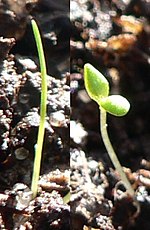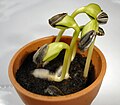Dicotyledon (redirect from Dicots)
The dicotyledons, also known as dicots (or, more rarely, dicotyls), are one of the two groups into which all the flowering plants (angiosperms) were formerly...
14 KB (782 words) - 01:10, 11 March 2024
plants with two embryonic leaves are termed dicotyledonous ("dicots"). In the case of dicot seedlings whose cotyledons are photosynthetic, the cotyledons...
13 KB (1,311 words) - 10:54, 12 May 2024
Plant stem (section Dicot stems)
arrangement of the vascular tissues varies widely among plant species. Dicot stems with primary growth have pith in the center, with vascular bundles...
18 KB (2,152 words) - 09:22, 11 June 2024
= seed leaf). Previously, they were called tricolpates or non-magnoliid dicots by past authors. The current botanical terms were introduced in 1991, by...
15 KB (1,295 words) - 00:00, 25 March 2024
Dicot is a Japanese musical duo. The members, Shino and Kana, both grew up in Fukuoka Prefecture and met at Fukuoka Women's Junior College in 1997 as...
4 KB (508 words) - 01:11, 17 May 2021
monocotyledons (monocots) have one blade-shaped cotyledon, whereas dicotyledons (dicots) possess two round cotyledons. Gymnosperms are more varied. For example...
11 KB (1,384 words) - 09:15, 17 October 2023
with the fruit wall to form a pericarp.) The testae of both monocots and dicots are often marked with patterns and textured markings, or have wings or tufts...
76 KB (9,426 words) - 14:10, 25 May 2024
(de-etiolated) seedlings Etiolated characteristics: Distinct apical hook (dicot) or coleoptile (monocot) No leaf growth No chlorophyll Rapid stem elongation...
16 KB (1,934 words) - 22:37, 14 April 2024
Monocotyledon (section Comparison with dicots)
flowering plants have two cotyledons and are classified as dicotyledons, or dicots. Monocotyledons have almost always been recognized as a group, but with...
115 KB (11,096 words) - 03:47, 13 May 2024
and Poaceae. Dicot plant families that include monocarpic species include Acanthaceae, Apocynaceae, Asteraceae, and Fabaceae. Few dicot shrubs with multiple...
4 KB (426 words) - 09:58, 10 May 2024
and Silurian periods. Many monocots like maize and the pineapple and some dicots like the Asteraceae have since independently evolved pathways like Crassulacean...
137 KB (14,447 words) - 04:07, 9 June 2024
Germination (section Dicot germination)
Germination is the process by which an organism grows from a seed or spore. The term is applied to the sprouting of a seedling from a seed of an angiosperm...
29 KB (3,669 words) - 07:13, 23 May 2024
parsley 3,780 Eudicot Brassicaceae or Cruciferae cabbage 3,710 Magnoliid dicot Piperaceae pepper 3,600 Monocot Bromeliaceae bromeliad 3,540 Eudicot Acanthaceae...
79 KB (6,233 words) - 17:39, 14 June 2024
Carnivorous plant (section Dicots)
Carnivorous plants are plants that derive some or most of their nutrients from trapping and consuming animals or protozoans, typically insects and other...
102 KB (11,844 words) - 02:33, 8 June 2024
Alcea rosea, the common hollyhock, is an ornamental dicot flowering plant in the family Malvaceae. It was imported into Europe from southwestern China...
6 KB (471 words) - 08:57, 21 April 2024
endodermis and phloem in plant roots. In dicot stems, it is situated around the ring of vascular bundles in the stele. In dicot roots, the pericycle strengthens...
3 KB (326 words) - 23:29, 13 February 2024
the seed plants was seen as between monocots and dicots, with gymnosperms as a small subset of the dicots. In 1851, Hofmeister discovered the changes occurring...
14 KB (1,567 words) - 22:57, 9 May 2024
especially in relation to grasslands and understory. Typically these are dicots without woody stems. The word "forb" is derived from Greek phorbḗ (φορβή)...
5 KB (457 words) - 12:54, 13 May 2024
A list of prehistoric and extinct species whose fossils have been found in the La Brea Tar Pits, located in present-day Hancock Park, a city park on the...
160 KB (5,577 words) - 15:38, 5 May 2024
crop so that it might be easier to control the monk's pepper plant, the dicot. Because the fruits of monk's pepper tend to fall constantly and uncontrollably...
19 KB (2,107 words) - 14:30, 30 May 2024
13-to-25-millimetre (1⁄2 to 1 in) range. Hardwood plywood is made out of wood from dicot trees (oak, beech and mahogany) and used for demanding end uses. Hardwood...
28 KB (3,533 words) - 09:53, 16 June 2024
trade, and was used by ancient Greeks and Romans. The distantly related dicots in the genus Asarum are commonly called wild ginger because of their similar...
45 KB (5,356 words) - 05:29, 27 March 2024
most of South Asia and the Far East. Largely overridden by breadfruit (a dicot tree) during the South Pacific's part of the Austronesian expansion. Wheat...
59 KB (5,149 words) - 18:58, 7 June 2024
rye spelt teff triticale wheat wild rice Starchy grains from broadleaf (dicot) plant families: amaranth (Amaranth family) also called kiwicha buckwheat...
9 KB (1,756 words) - 18:31, 16 June 2024
flowering plant species in the family Polygonaceae. Rumex sanguineus is a dicot and can be observed in Europe with at least two varieties. The leaves are...
6 KB (647 words) - 07:47, 14 June 2024
Other specialized leaves include those of Nepenthes, a pitcher plant. Dicot leaves have blades with pinnate venation (where major veins diverge from...
113 KB (11,767 words) - 19:34, 14 June 2024
sealed containers, or techniques such as injection of the bacteria into a dicot plant, which is an environment with limited oxygen. The GasPak System is...
23 KB (2,493 words) - 12:27, 12 June 2024
monocots (grasses) such as Echinochloa crus-galli (barnyard grass) and dicots (forbs) such as Chenopodium and Amaranthus may compete with maize and reduce...
86 KB (8,973 words) - 16:28, 5 June 2024
Phytogb1: splits into two parts for monocots and dicots respectively. Phytogb2: exclusively found in dicots. Lb: leghemoglobin, the legume symbiotic globin...
19 KB (2,397 words) - 06:19, 11 March 2024
HomoloGene (section Dicots)
HomoloGene, a tool of the United States National Center for Biotechnology Information (NCBI), is a system for automated detection of homologs (similarity...
4 KB (340 words) - 07:38, 26 April 2024























